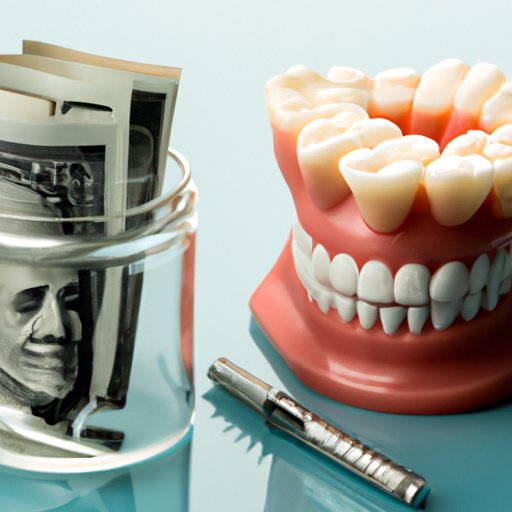Introduction
For many people, having a healthy, attractive smile is important for their self-confidence and overall wellbeing. Unfortunately, tooth loss due to decay, injury, or illness can have a devastating effect on a person’s self-esteem. Fortunately, there are various restorative options available to replace missing teeth and restore a person’s smile. One popular option is to get false teeth, also known as dentures. But how much do fake teeth cost? This article will provide a comprehensive overview of the cost of false teeth and other restorative options.
Comparing the Cost of Fake Teeth: What You Need to Know
When it comes to replacing missing teeth, there are two main options: dental implants and false teeth. Dental implants are titanium screws that are surgically placed in the jawbone to act as artificial tooth roots. False teeth, sometimes referred to as dentures, are removable prosthetics that rest on the gums and can be taken out and cleaned when needed. Both options can be used to replace one or more missing teeth.
When exploring the cost of fake teeth, it’s important to understand the difference between dental implants and false teeth. While dental implants tend to be more expensive than false teeth, they offer several advantages over false teeth, such as better stability and a more natural look and feel. On the other hand, false teeth tend to be more affordable and easier to maintain, making them a good option for those on a budget.
How Much Do Fake Teeth Cost? An Overview
When considering the cost of fake teeth, it’s important to keep in mind that there are several types of false teeth available. The most common types of false teeth include full dentures, partial dentures, and flexible dentures. Each type of denture has its own set of benefits and drawbacks, and the cost of each type varies depending on the materials used and the complexity of the design.
In addition to the type of denture, there are several factors that can affect the cost of fake teeth, including the number of teeth being replaced, the complexity of the restoration, and the materials used. For example, dentures made with higher-quality materials such as porcelain or gold may be more expensive than dentures made with less expensive materials such as acrylic. Additionally, dentures that require complex designs or additional services such as relining or rebasing may cost more than simpler designs.
On average, full dentures can cost anywhere from $300 to $5,000, while partial dentures can range from $500 to $3,000. Flexible dentures are typically the most expensive type of denture, costing up to $10,000. However, the exact cost of fake teeth will depend on the individual needs of the patient and the materials used.

Considering Costs: Fake Teeth and Other Restorative Options
In addition to false teeth, there are several other restorative options available for replacing missing teeth. These options include bridges, crowns, and dental implants. Bridges are typically less expensive than dentures, with the cost ranging from $1,000 to $4,000 per tooth. Crowns, which are used to restore damaged teeth, can cost anywhere from $500 to $3,000 per tooth. Lastly, dental implants, which are the most expensive option, can range from $1,000 to $6,000 per tooth.
When deciding which restorative option is right for you, it’s important to consider the pros and cons of each option. While false teeth are generally the least expensive option, they are not as stable or durable as dental implants. Bridges and crowns can be more costly, but they provide a more natural look and feel. Dental implants are the most expensive option, but they are the most stable and long-lasting.
Weighing the Benefits of Fake Teeth: Is it Worth the Cost?
False teeth can be a great way to restore your smile. They are generally cheaper than other restorative options and can be easily removed for cleaning and maintenance. In addition, false teeth are often more comfortable and easier to adjust than other options. However, false teeth can be prone to slipping and shifting, and they may need to be replaced more frequently than other options.
Ultimately, the decision to get false teeth should be based on your individual needs and budget. If you’re looking for a more permanent solution, dental implants may be a better option. However, if you’re on a tight budget or don’t want to undergo surgery, then false teeth may be a good option for you.
Conclusion
False teeth can be a great way to restore your smile. But how much do they cost? This comprehensive guide has explored the different types of false teeth and their associated costs, as well as other restorative options. Ultimately, the decision to get false teeth should be based on your individual needs and budget. Weigh the pros and cons of each option before making a decision.
(Note: Is this article not meeting your expectations? Do you have knowledge or insights to share? Unlock new opportunities and expand your reach by joining our authors team. Click Registration to join us and share your expertise with our readers.)
